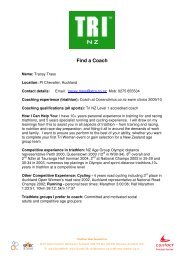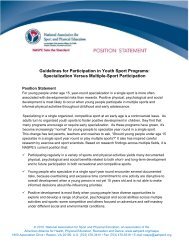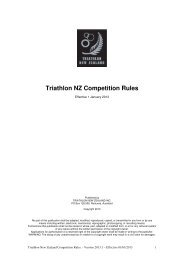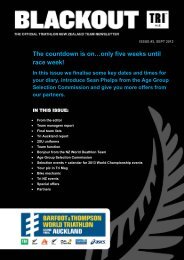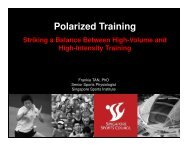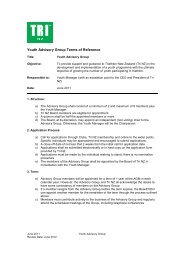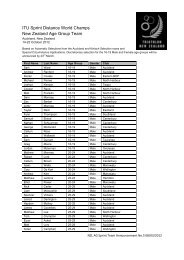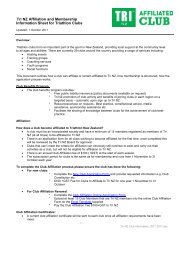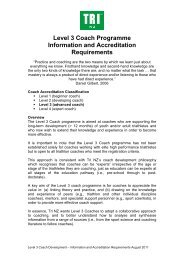The Science of Cycling - IngentaConnect
The Science of Cycling - IngentaConnect
The Science of Cycling - IngentaConnect
Create successful ePaper yourself
Turn your PDF publications into a flip-book with our unique Google optimized e-Paper software.
<strong>The</strong> <strong>Science</strong> <strong>of</strong> <strong>Cycling</strong>: Part 1 287<br />
Overuse and over-training disabilities common to the competitive cyclist, if<br />
untreated, can lead to delayed recovery.<br />
<strong>Cycling</strong> remains the major means <strong>of</strong> transportation<br />
in many countries <strong>of</strong> the world and, as a recreational<br />
and competitive sport, it continues to grow<br />
increasingly popular. Furthermore, during the last<br />
decade, <strong>of</strong>f-road cycling has enjoyed an exponential<br />
growth in popularity. While cycling has continued<br />
to expand as a recreational/fitness activity, so has<br />
the competitive nature <strong>of</strong> the sport. Competitive<br />
cycling requires both aerobic and anaerobic power.<br />
Road and <strong>of</strong>f-road bicycle racing require the cyclist<br />
to possess the ability to generate a relatively high<br />
power output <strong>of</strong> short duration during the mass start,<br />
steep climbing and at the race finish.<br />
<strong>The</strong> typical road race and <strong>of</strong>f-road cross-country<br />
cycle events may have durations <strong>of</strong> approximately<br />
1–5 hours while multi-stage races are characterised<br />
by several back-to-back days <strong>of</strong> racing consisting <strong>of</strong><br />
mass-start stages and individual and team time tri-<br />
als. Pr<strong>of</strong>essional cyclists must be able to tolerate<br />
high work-loads for long periods (3 weeks) during<br />
major tour races such as the Giro d’Italia, Tour de<br />
France and Vuelta a España. During these competitive<br />
events, the power output <strong>of</strong> the cyclist is used to<br />
overcome the aerodynamic and rolling resistances.<br />
Different by the nature <strong>of</strong> the setting, competitive<br />
track cycling demands acute bursts <strong>of</strong> high power<br />
output followed by constant high-intensity sprint-<br />
ing. This article attempts to provide an overview <strong>of</strong><br />
the physiological and metabolic factors associated<br />
with cycling performance. A better understanding <strong>of</strong><br />
the mechanisms and their interactions that underlie<br />
excellence in the dynamics <strong>of</strong> cycling will enable<br />
more educated approaches to testing, training and<br />
research.<br />
1. Terminology and Research Design<br />
Recent literature has questioned the application<br />
and interpretation <strong>of</strong> terminology and concepts commonly<br />
found in scientific papers that address topics<br />
related to exercise science. [1-7] Consequently, prior<br />
to this review, some interpretative commentary <strong>of</strong><br />
concepts and terminology is considered necessary.<br />
Furthermore, research design, subject sample, sam-<br />
ple size, instrumentation, methodology and data ac-<br />
quisition are addressed.<br />
1.1 Terminology<br />
<strong>The</strong> following terms are prevalent in cycling<br />
literature; however, the definition <strong>of</strong> these terms is<br />
<strong>of</strong>ten absent or inconsistent. For clarification and<br />
consistency, the terms with their definitions are<br />
presented.<br />
‘Anaerobic’ is considered a non-oxygen meta-<br />
bolic concept that represents enzyme concentrations<br />
and activity. In the present article, the term anaerob-<br />
ic relates to those metabolic processes that do not<br />
depend on oxygen, irrespective <strong>of</strong> its availability. [6]<br />
‘Maximal oxygen uptake ( ˙VO2max)’ represents<br />
the maximal oxygen used, and is limited by oxygen<br />
delivery and subject to central and peripheral cardio-<br />
vascular capacity limitations and tissue oxygen de-<br />
mand.<br />
‘Efficiency’ is a measure <strong>of</strong> effective work and is<br />
most commonly expressed as the percentage <strong>of</strong> total<br />
energy expended that produces external work. [7]<br />
‘Lactate threshold 1 (LT1)’ is defined as the<br />
exercise intensity that elicits 1 mmol/L increase in<br />
blood lactate concentration above the average rest<br />
value. [8] It is identified on the individual power<br />
curve as the intensity eliciting such a blood lactate<br />
increase. This threshold has several names, such as<br />
lactate threshold, aerobic threshold and anaerobic<br />
threshold. However, we will use the term ‘threshold<br />
1’ to represent the first break-point on the lactate-<br />
intensity curve.<br />
‘Lactate threshold 2 (LT2)’ is the highest exercise<br />
intensity at which blood lactate concentration<br />
remains stable and is <strong>of</strong>ten referred to as maximal<br />
lactate steady state (MLSS). MLSS is attained when<br />
blood lactate concentration varies



